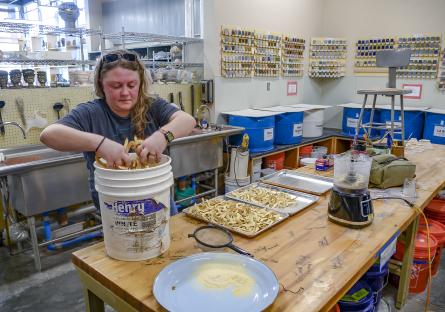
Sustainability Effort Tastes Sweet
The desert is a surprising place. For those unfamiliar with the environment, it can feel like it’s nothing more than just hot and, well, brown. But if you look closely, the desert ecosystem is quite impressive. Kendra Stanger, Environmental Technology Center (ETC) Coordinator at Chandler-Gilbert Community College (CGCC), helps students learn about Arizona through programs that bring environmental lessons to life.
The ETC at CGCC is more than just a garden; it is a program developed by a collaboration of instructors from various departments and academic disciplines who worked with students from their classes, Honors programs, clubs, and community groups to experiment with sustainability theories. Through their collective knowledge, this group transformed a dusty, two-acre plot of land into an outdoor garden-based classroom.
The current ETC project teaches how to convert desert mesquite pods into food. Mesquite shrubs or small trees are common in the Southwest, and their bean-like pods can be a nutritious food source to humans and wildlife. For this sustainability initiative, Stanger describes the process of converting the pods to flour:
“Don’t let your mesquite pods go to waste! They may seem like a nuisance, but they are some of the most plentiful FREE food products around the valley. Mesquite is a high-protein food, highly nutritious, rich in iron, calcium, magnesium, potassium, zinc, and lysine. It digests slowly, has a high fiber and protein content and is low on the glycemic index. In a few simple steps, you can turn those pesky pods into usable flour for many different recipes. All you must do is:
- Harvest the pods. They are available from June-September, but it’s best if you get them right off the tree. Set up a tarp underneath the tree, shake to dislodge, and all pods that fall without pulling are ready. The best way to find out if your mesquite tree has pods worth harvesting is to taste them! Here in the Valley there are several varieties, but the two most common are Honey and Velvet mesquite. Take a pod from the tree, chew it just a bit, if you like the flavor, harvest from that tree. Due to cross pollination and hybridization, some won't taste good. If you taste the pod and it's bitter, or sucks the moisture from your mouth, move on... there are better trees.
- Sort through and get rid of twigs, leaves and other debris you’ve accumulated while harvesting.
- Toast or dry the pods to get rid of beetles and other undesirables that may have gotten into the pods. (We toasted in CGCC’s Ceramics Kiln at 185 degrees F for 1-2 hours.)
- Blend in a food processor or mortar and pestle until you have a flour-like consistency.
- Sift with a mesh strainer to get all the unblended seeds or husks out.
There are some facilities that will mill your pods for you. It took me about half an hour to turn one five-gallon bucket of already toasted pods into 2 pounds of flour using a food processor. So, if you’ve got much more than that… it might be worth the trip.
Mesquite flour is gluten free. If you have experience baking with gluten free products, use it as you normally would another gluten free flour such as almond or coconut. Keep in mind it is on the sweet side. If you are wanting to use it to cook or bake with like regular flour, use 1/4 cup mesquite flour and 3/4 cup regular flour for 1 full cup. Mesquite flour has been used to make tortillas, sweet breads, pancakes, cookies, muffins and cakes because it is sweet, but it can also be added to soups, gravies and sauces, casseroles, vegetable and meat dishes, and pie crusts."
Instructions, videos, and recipes for using the flour are available online. The Arizona-Sonora Desert Museum offers ideas at https://www.desertmuseum.org/center/edu/docs/k-2_TIP_recipes.pdf. And if you have any questions, comments, concerns, or ideas, Stanger welcomes emails to Kendra.Stanger@cgc.edu.
Projects such as the Mesquite Pods harvest support the Chandler-Gilbert Community College vision for its students to be prepared to lead the community into a promising and sustainable future. To find out more about CGCC interdisciplinary Experiential Learning, visit https://www.cgc.edu/academics/experiential-learning/environmental-technology-center, and degree paths to support sustainability career options are described at https://www.cgc.edu/degrees-certificates/sustainability. Sustainability is more than a buzzword, it’s a way of life—and a possible career!
